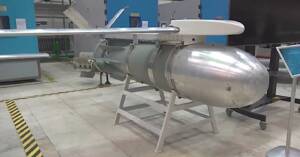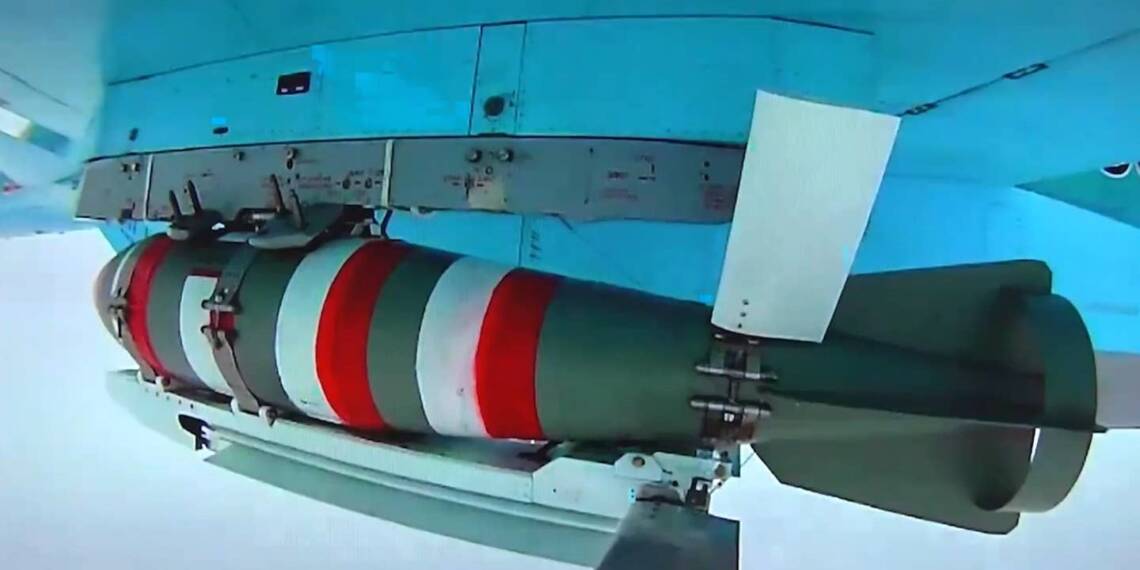Russia now has bombs that, to put it simply, cannot be overpowered.
Russia has significantly advanced the capabilities of their post-Soviet arsenal. The Soviet-era FAB-1500, a conventional 1500-kilogram (approximately 3,300 pounds) dead drop bomb has been transformed into a modern glide bomb. By equipping the FAB-1500 with flight kits, including pop-out wings, the weapon system has been markedly upgraded to enhance its operational flexibility and effectiveness.
Join us on Telegram: https://t.me/tfiglobal
The updated FAB-1500 measures 4.1 meters (around 13 feet 5 inches) in length and contains an explosive payload of 680 kilograms (about 1,500 pounds) of high explosives. It utilizes either an inertial navigation system (INS) or GLONASS (the Russian equivalent of GPS) for guidance, allowing it to accurately target locations from a distance. The addition of pop-out wings enables the bomb to glide up to 50 kilometers or more towards its target, significantly increasing its range and accuracy compared to traditional drop bombs.

This innovative approach not only demonstrates a cost-effective method of enhancing the capabilities of existing munitions but also reflects a strategic adaptation to modern warfare requirements. The Russian military has made significant strides in the modernization of its arsenal, particularly with the extensive deployment of the FAB-1500 glide bomb. Reportedly, there have been instances where over 100 of these bombs were utilized daily, creating craters exceeding 50 feet in diameter upon impact.
Read More: Russia, China, and Iran Conduct Joint Exercises
The FAB-1500 has been praised for its devastating effectiveness, particularly due to the concussive force it unleashes upon detonation. This makes it especially lethal against fortified positions, defensive installations, and troop concentrations. Russian officials claim an impressive accuracy rate of within five meters.
This advancement signifies a pivotal enhancement of the Soviet-era munitions, placing Russia in the advanced stages of utilizing the FAB-1500 within its current military operations. The significant inventory of these weapons at Russia’s disposal, surpasses that of the United States’ Joint Direct Attack Munition (JDAM). The JDAM system has been a cornerstone of the U.S. strategy to upgrade its Cold War-era munitions, yet Russia’s deployment of the FAB-1500 suggests a parallel approach.
The deployment of the FAB-1500 glide bomb by Russia presents a unique and formidable challenge to Ukraine, which lacks a comparable capability. This disparity underscores a significant tactical disadvantage, as Ukraine does not possess an air force capable of preemptively striking Russian aircraft before they can deploy these weapons. The notion of countering this threat with American F-35 fighter jets has been met with skepticism, largely due to perceived inadequacies in their performance under the specific conditions of the conflict.
The challenges extend beyond merely acquiring advanced aircraft; even if Ukraine were to obtain F-35s, the logistical and operational hurdles, including operating from damaged runways and within contested airspaces heavily monitored by Russian defenses, make their effective deployment highly improbable.
Thus, the enduring advantage conferred by the FAB-1500 glide bomb is likely to persist, reshaping the tactical landscape to Russia’s favor. The only conceivable countermeasure for Ukraine would involve disrupting the logistical support systems that underpin Russian air operations—a task daunting in its complexity and as likely as spotting a Yeti riding a Harley Davidson.
The introduction and deployment of the FAB-1500 glide bomb represent a pivotal moment in the evolution of Russian military capabilities, marking the most significant enhancement in its power projection in the last three decades. This advancement is not merely theoretical but has been practically applied in active conflict zones.
Read More: Poland ASKING Russia to PUT IT OUT of its MISERY
The strategic implications of this development extend far beyond the immediate battlefield, with the potential to fundamentally alter the balance of power along the entire front, especially in Eastern conflict zones.
For a long time, the West has operated under the assumption that Russia’s military successes were primarily attributed to its numerical advantage rather than technical innovation. The effective use of the FAB-1500 shatters this perception, serving as a stark reminder of Russia’s growing technical prowess and its ability to leverage such advancements in enhancing its strategic position.








